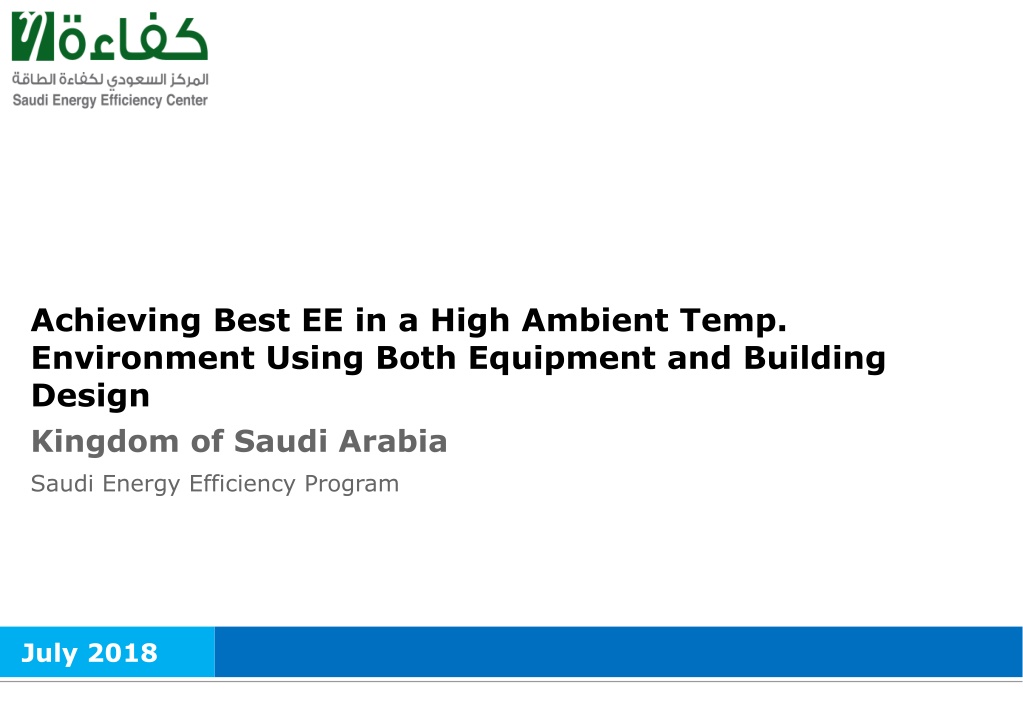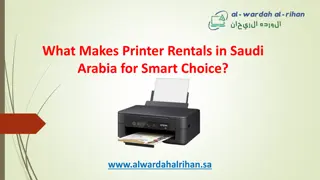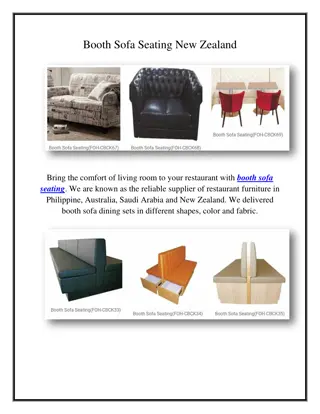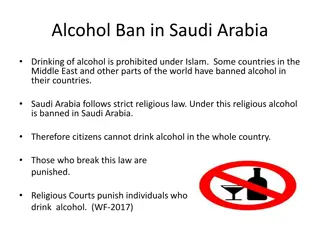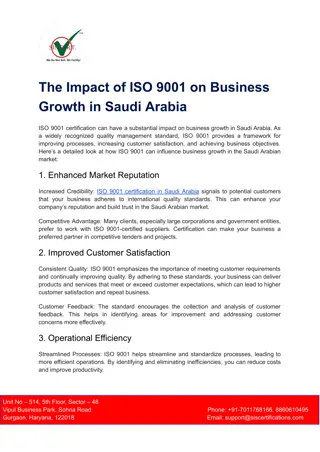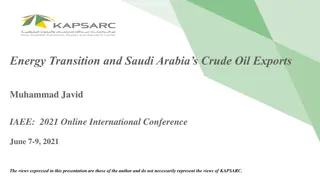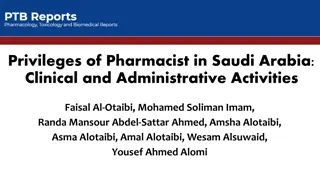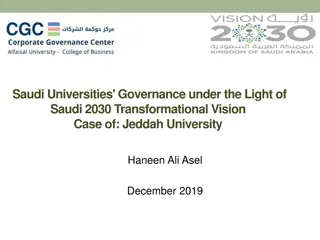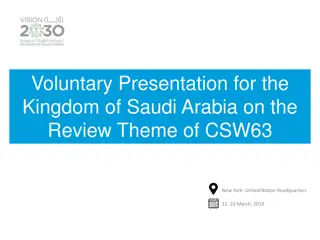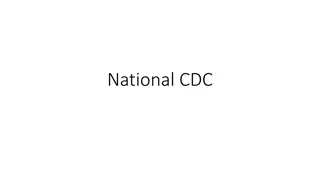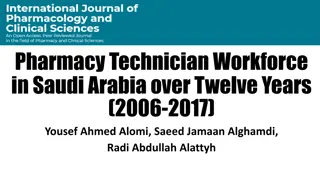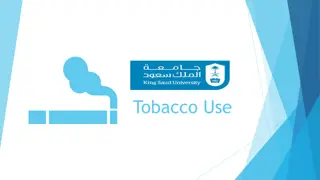Enhancing Energy Efficiency in Saudi Arabia: SEEC's Impactful Initiatives
The Saudi Energy Efficiency Center (SEEC) plays a crucial role in improving energy efficiency in Saudi Arabia through strategic programs and initiatives. Established in 2010, SEEC focuses on sectors like transportation, industry, and buildings, with a goal to reduce energy consumption and promote awareness. By following the three Is cycle - Identification, Implementation, Integration - SEEC identifies opportunities for energy savings, implements effective strategies, and integrates energy efficiency practices across various sectors. Through initiatives like the Saudi Energy Efficiency Program (SEEP), SEEC is instrumental in driving sustainable energy practices in the Kingdom.
Download Presentation

Please find below an Image/Link to download the presentation.
The content on the website is provided AS IS for your information and personal use only. It may not be sold, licensed, or shared on other websites without obtaining consent from the author. Download presentation by click this link. If you encounter any issues during the download, it is possible that the publisher has removed the file from their server.
E N D
Presentation Transcript
Achieving Best EE in a High Ambient Temp. Environment Using Both Equipment and Building Design Kingdom of Saudi Arabia Saudi Energy Efficiency Program DRAFT July 2018
The Saudi Energy Efficiency Center was initiated based on a clear case for change KINGDOM HAS HAD A STEEP INCREASE IN ENERGY CONSUMPTION (1): MMBDOE = million barrel a day of oil equivalent 1
SEEC was founded to enable the Kingdom to embark on an ambitious Energy Efficiency effort Description Mission Key objectives Established through Council of Ministers in 2010 Improve Saudi Arabia energy efficiency and coordinate all related activities between stakeholders Develop energy efficiency program Launched the Saudi Energy Efficiency Program (SEEP) in 2012 Coordinate between all stakeholders to propose energy efficiency policies and regulations, and monitor their implementation Promote awareness 2
The establishment of the Center reflects the interest of the state in rationalizing and upgrading energy efficiency in KSA 2013 2018 Now 2010 2012 SEEP Full-fledged program with 12 teams New mandate for SEEC has been approved in 2018 Inter-agency effort to launch the Saudi Energy Efficiency Program (SEEP), with guiding principles, a clear strategy and strong governance Program covered mainly demand management for the following sectors: - Transportation - Industry - Buildings Established through Council of Ministers decision Scope of work expanded to cover: - Power generation - Water desalination - Feedstock in industry ~80 initiatives at different stages (feasibility, design, execution) 3
SEECs efforts follow the three Is cycle Identification Implementation Integration 4
Identification: SEEC identifies and prioritizes sectors based on potential savings in energy consumption Identification Implementation Integration 5
The Saudi Energy Efficiency Program identified and focused on the three sectors with the highest energy consumption in KSA KSA ENERGY CONSUMPTION 38% Petchem others 21% Cement 11% Steel 40% 90% 52% Light duty 90% 40% Major sectors 21% Heavy duty 65% 10% 10% 29% 4% Based on the Kingdom s energy consumption statistics in 2016 6
Industry: Overview of SEEPs ongoing initiatives and planned initiatives for 2018 - 2020 2012 - 2017 2018 - 2020 Initiative Developed baseline for 180+ Saudi petchem, cement and steel plants for ~50 different production processes Established energy intensity (EI) targets based on international benchmarks for the petchem, cement and steel processes: Developed enforcement mechanism with 11 government entities to leverage their current mandates to help plants reach their aspirational improvement level and signed a joint agreement in this regard Implementing the new and existing plantsframeworks (i.e. EI targets) on the petchem, cement and steel sub-sectors Assessing the applicability of the existing and new plants frameworks (i.e. EI targets) on the aluminum sub-sector Developing new frameworks to cover new sub-sectors (other than petchem, cement, steel and aluminum) in SEEC s scope New and existing plants energy efficiency Issued standard in December 2013 (SASO IEC 60034-30) Started implementing MEPS (minimum energy performance standard) in August 2015 Updating the standard to align with best international practices - The new standard will be issued in 2018 Electric motors standard Developing support structure to help industrial plants in implementing energy management system such as ISO 50001 Energy management system Developed factbase on Energy Management System (EnMS) 7 This draft document is confidential and was prepared by the Saudi Energy Efficiency Program technical team for internal use only; It is not to be relied on by any 3rd party without prior SEEP technical team consent
The Saudi Energy Efficiency Program identified and focused on the three sectors with the highest energy consumption in KSA KSA ENERGY CONSUMPTION 38% Petchem others 21% Cement 11% Steel 40% 90% 52% Light duty 90% 40% Major sectors 21% Heavy duty 65% 10% 10% 29% 4% Based on the Kingdom s energy consumption statistics in 2016 8
Transportation: Overview of SEEPs ongoing initiatives and planned initiatives for 2018 - 2020 2012 - 2017 2018 - 2020 Initiative Fuel Issued the fuel economy standard in November 2014 Started implementing the standard in January 2016 Developing and issuing phase 2 (2021- 2025) of the fuel economy standard Updating the standard to include electric vehicle fuel economy calculation economy standard for light duty vehicles Tire Rolling resistance/ wet grip Issued a standard in April 2014 based on the work done by the EU Started implementing the standard in November 2015 Enforcing the phase 2 standard in November 2019 Enforcing the phase 2 label for 2019 MY vehicles Updating label to include electric vehicles Fuel Issued a standard in December 2013 Started implementing the standard in August 2014 economy label Drafted a first version of the aerodynamic regulation and shared it with the manufacturers HDV Implementing the aerodynamic regulation regulations On the road program Benchmarked scrappage programs that take place around the world Finalizing the feasibility analysis of the program implementation 9 This draft document is confidential and was prepared by the Saudi Energy Efficiency Program technical team for internal use only; It is not to be relied on by any 3rd party without prior SEEP technical team consent
The Saudi Energy Efficiency Program identified and focused on the three sectors with the highest energy consumption in KSA KSA ENERGY CONSUMPTION 38% Petchem others 21% Cement 11% Steel 40% 90% 52% Light duty 90% 40% Major sectors 21% Heavy duty 65% 10% 10% 29% 4% Based on the Kingdom s energy consumption statistics in 2016 10
Buildings: We have designed and issued 22 energy efficiency standards and regulations for the buildings sector 2012 - 2017 2018 - 2020 Initiative Issued the small AC standard in 2012 according to the ASHRAE values - finalizing a new update for the standard Issued the large AC standard in collaboration with AHRI. https://encrypted-tbn0.gstatic.com/images?q=tbn:ANd9GcRQJAd0OFs3kKjAltBu_UAD_GRvNmtx0tWxKy__akHd8AlSt3SrRg Continue standard enforcement and begin enforcement for updated standard Air conditioners Issued 15 thermal insulation standards Issued a thermal insulation regulation for new buildings in collaboration with ASHRAE Thermal insulation Continue standard enforcement Issued the standards in 2013 (Refrigerators, Freezers, Washing Machines) Began enforcement andcurrently finalizing the washing machines and refrigerator standard updates as well as a new standard for clothes dryers Continue enforcement for current standards and begin enforcement for new/updated standards White goods Saudi Building Code (SBC) Updated, in collaboration with ASHRAE, the energy efficiency section of the SBC Approve and enforce the Building code update Conducted a feasibility study and built a solid fact base based on international practices Obtained approval to begin the high-level design of the EUI initiative Energy Use Intensity (EUI) Aim to complete initiative design and begin implementation by 2020 Water heaters Finalizing a new standard for water heaters Begin standard enforcement Issued the first part of the lighting product standard in Q3 2015 Currently submitting the second part of the lighting product standard to the World Trade Organization (WTO) Continue enforcement for Lighting part I and begin enforcement for Lighting part II Lighting products 11
Integration: SEEC engages stakeholders on all sides to utilize expertise, inputs, and feedback Identification Implementation Integration 12
SEEPs initiatives are developed by integrating inputs from all involved stakeholders Design stage input providers Government entities End users Private sector International entities Technical experts For proper design and execution, we have engaged 150+ representatives from 30+ government entities To identify and resolve technical challenges To adapt success stories and avoid pitfalls To devise technical solutions to the challenges faced For continuous feedback on initiative design 13
SEEPs initiatives are developed by integrating inputs from all involved stakeholders Government entities SEEP S ROLE For proper design and execution, we have engaged 150+ representatives from 30+ government entities Guide governmental stakeholders towards consensus on all proposed policies Ensure no entity s mandate is violated or stepped-over Enable the entities for implementation by highlighting the needed resources and supporting their acquisition 14
SEEPs initiatives are developed by integrating inputs from all involved stakeholders Design stage input providers Private sector International entities Technical experts To identify and resolve technical challenges To adapt success stories and avoid pitfalls To devise technical solutions to the challenges faced SEEP S ROLE Involve manufacturers, importers, labs, and international entities Learn from and apply global best practices Ensure implementation is feasible, fair, and befitting KSA needs 15
SEEPs initiatives are developed by integrating inputs from all involved stakeholders End users SEEP S ROLE Launch interactive awareness campaigns for all SEEP initiatives For continuous feedback on initiative design Provide constant communication to answer questions outside the campaigns Launched a mobile application (Ta kad) in 2015 to facilitate making purchase choices based on energy efficiency and verifying genuine products (~570k current users) 16
Implementation: SEEC supports the relevant entities in executing the outputs of the previous steps Identification Implementation Integration 17
Implementing EE standards on equipment resulted in notable improvements for the affected products SMALL AC REFRIGERATORS https://encrypted-tbn0.gstatic.com/images?q=tbn:ANd9GcRQJAd0OFs3kKjAltBu_UAD_GRvNmtx0tWxKy__akHd8AlSt3SrRg Increased T1 EER 57% for split-type ACs and 36% for window-type from 2012 to 2018 32% 26% Only increased T3 EER for split-type ACs by 35% and for window types by 14% since 2012 due to ambient temperature limitations on usable gases Reduced the maximum allowed electricity consumption by 26-32% between 2007 and 2013 revisions 18
Improvements in T3 EER for small ACs were limited in comparison to T1 SMALL AC Energy Efficiency Ratio (EER) https://encrypted-tbn0.gstatic.com/images?q=tbn:ANd9GcRQJAd0OFs3kKjAltBu_UAD_GRvNmtx0tWxKy__akHd8AlSt3SrRg 11.8 12 11.5 11 10 9.5 9.8 9.8 9 8.3 8.28 8.5 8 7.5 7.5 Increased T1 EER 57% for split-type ACs and 36% for window-type from 2012 to 2018 7 6.84 7 7 6.12 6.12 6 6.12 5 4 2007 2012 2014 2018 Only increased T3 EER for split-type ACs by 35% and for window types by 14% since 2012 due to ambient temperature limitations on usable gases Split EER @ T1 Window EER @ T1 Split EER @ T3 Window EER @ T3 Any alternative gases considered should allow raising the T3 EER limitations 19
The implemented standards for AC also include large capacity ACs Electrically operated air conditioners Condensing units Chillers Scope VRF Absorption chillers Close control air conditioners and condensing units serving computer rooms Electrically operated air conditioners vary by type and capacity, EER from 9.7 to 12.5 Condensing units vary by type and capacity, EER from 10.5 to 13.5 Minimum Energy Performance Standard (MEPS) Chillers vary by type and capacity, EER from 9.7 to 20.5 VRF vary by type and capacity, EER from 9.5 to 12.0 Absorption chillers vary by type and capacity, EER from 2.0 to 3.4 Close control air conditioners and condensing units serving computer rooms vary by type and capacity, COP from 1.70 to 2.70* (*) Note: EER=COP*3.41 20
The improved efficiency of the AC significantly contributes to lowering electricity consumption and demand BEFORE UPDATING STANDARD (2012) AFTER UPDATING STANDARD (2018) Inefficient AC units: - Quantity: 4 , EER: 7.5 - Capacity: 18,000 Btu/h - Electricity demand : 9.6 kW - Electricity consumption:25,920 kWh/year Efficient AC units: - Quantity: 4 , EER: 11.8 - Capacity: 18,000 Btu/h - Electricity demand: 6.1 kW - Electricity consumption:16,470 kWh/year 36% reduction in load/consumption due to standard update fuel used in Generation GHG emissions Note: 2,714 operating hours per year at full load equivalent assumed in the calculations 21
How High Ambient Temperature conditions affect the heat load and the system efficiency zone 1 represent 70-80% of total KSA population. (HAT) could reach around 50 C in summer, this will lead to: Up to 12 daily Operating hours for ACs. + 30% decrease in AC efficiency. Saudi Arabia Climate Zones 10 year (SI) DB max C 49.8 47.7 49.3 42.3 49.2 47.2 DB 1% C 46 44.2 44 37.9 44.1 43.9 Zone 1 is extremely hot with CDD 18.3 C greater than 5,000; Zone Elevation m 178 636 17 7 240 620 CDD18.3 CDD10 Latitude 25.30N 24.55N 26.27N 16.88N 21.43N 24.70N Longitude 49.48E 39.70E 50.17E 42.58E 39.77E 46.73E AL-AHSA AL-MADINAH DHAHRAN GIZAN MAKKAH RIYADH OBS. (O.A.P.) 1 1 1 1 1 1 3573 3757 3398 4409 4758 3342 6389 6715 6258 7451 7800 6107 Zone 2 is very hot with CDD 18.3 C greater than 3,000; Zone 3 is hot for the remaining cities. Saudi Arabia Climate Data by City 22
Going beyond equipment, SEEP has initiatives targeting energy efficient building design INSULATION MATERIALS SAUDI BUILDING CODE ENERGY USE INTENSITY (EUI) Introduced standards for 15 insulation types used in the Kingdom Updated the Saudi Building Code concerning energy efficiency in buildings (SBC-601) to mandate use of standard- compliant insulation Currently designing a program to rate buildings based on their EUI (energy consumption per square meter) - One aim of the program is to make energy efficient design more attractive to design offices Began enforcing insulation requirements on residential buildings in 2015 Also added requirements for ventilation and use of energy efficient equipment 23
To ensure the standards are properly followed, SEEC cooperates with relevant entities to enforce them ENFORCEMENT FOLLOWS THREE STAGES Monitoring and enforcement tours Announcement workshop Market Sampling 1 2 3 Within a year from the announcement of a standard, factory visits and customs ports monitoring for non-compliant products begin Announcement workshops are held for all standards with manufacturers, importers, laboratories Samples are purchased randomly from retailers across the kingdom The compliance statistics obtained from this plan serve to judge the effectiveness of the previous stages Dates and deadlines for the enforcement plan are declared Within the following year, visits for markets and warehouses to check efficiency labels begin Stages 2 and 3 are ongoing 24
The three stage enforcement process contributes to keeping the Saudi markets clean of low efficiency products ENFORCEMENT RESULTS SMALL AC INSULATION REFRIGERATORS https://encrypted-tbn0.gstatic.com/images?q=tbn:ANd9GcRQJAd0OFs3kKjAltBu_UAD_GRvNmtx0tWxKy__akHd8AlSt3SrRg Confiscated: ~960k Confiscated: ~78 tons Confiscated:184 Re-exported: ~352k Re-exported: 439 tons Re-exported: ~120k Recycled: ~338k Recycled: ~78 tons Recycled: 184 Refurbished: ~328k 25
SEECs efforts in energy efficiency helped slow the growth of electricity demand and consumption CAGR Before After ~5% 3.5% ~7% 3.7% 26
But these results can be severely impacted by changes to the allowed cooling gases If the alternatives proposed for the Montreal Protocol do not achieve the efficiency, safety, and the high ambient temperature requirements for KSA, we may lose the results of our efforts so far 27
Thank you DRAFT
